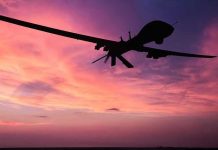
America’s 32-year nuclear testing moratorium just ended with a single social media post that could reshape global security forever.
Story Overview
- Trump ordered Pentagon to resume nuclear weapons testing “on an equal basis” with Russia and China
- First U.S. nuclear test order since 1992, breaking decades of international restraint
- Decision follows Russia’s successful test of nuclear-powered Burevestnik cruise missile in October 2025
- Nevada Test Site near Las Vegas likely location, raising fears of radioactive exposure for millions
The Tweet That Broke Three Decades of Peace
President Trump’s Truth Social announcement shattered the longest period of nuclear restraint in modern history. “Because of other countries testing programs, I have instructed the Pentagon to start testing our Nuclear Weapons on an equal basis. That process will begin immediately.” The timing was deliberate, issued just before his scheduled meeting with Chinese President Xi Jinping at the Asia-Pacific Economic Cooperation summit in South Korea.
The absence of official White House confirmation due to a government shutdown only amplified global uncertainty. Pentagon officials scrambled to interpret the directive while international partners questioned America’s commitment to nuclear nonproliferation treaties. The Comprehensive Nuclear-Test-Ban Treaty, signed but never ratified by the U.S., suddenly seemed like ancient history.
Russia’s Nuclear Gambit Forces America’s Hand
Russia’s October 21st test of the Burevestnik nuclear-powered cruise missile provided Trump the justification he needed. Moscow claimed success with a weapon capable of unlimited range and nuclear propulsion. This technological leap represented more than military advancement; it signaled Russia’s willingness to abandon Cold War restraints that kept nuclear competition in check.
The strategic implications are staggering. While America maintained its nuclear arsenal through computer simulations and maintenance, Russia and China advanced through active testing and development. Trump’s response acknowledges a harsh reality: American deterrence credibility depends on proven capability, not theoretical models. The question isn’t whether America should test, but whether it can afford not to test.
Nevada’s Atomic Legacy Returns to Life
The Nevada National Security Site, formerly the Nevada Test Site, conducted over 900 nuclear tests between 1951 and 1992. Located just 65 miles northwest of Las Vegas, the facility witnessed mushroom clouds visible from casino windows during the atomic age’s peak. Local residents developed “atomic parties,” gathering on rooftops to watch nuclear detonations with cocktails in hand.
Today’s Las Vegas metropolitan area houses 2.3 million residents who never experienced atomic testing’s reality. Underground testing eliminated visible mushroom clouds, but radioactive fallout remains a genuine concern. Environmental groups warn that renewed testing could contaminate groundwater systems serving millions across Nevada and California. The economic impact on tourism, Las Vegas’s lifeblood, could reach billions if public fear outweighs patriotic support.
Global Nonproliferation Framework Crumbles
Trump’s decision threatens the entire international arms control architecture. The Comprehensive Nuclear-Test-Ban Treaty Organization monitors global seismic activity for unauthorized nuclear tests. America’s withdrawal from voluntary compliance encourages other nations to abandon restraint. India, Pakistan, and North Korea already ignored international pressure; now they have superpower precedent.
China’s response will determine whether this becomes an arms race or strategic recalibration. Beijing’s nuclear modernization program accelerated dramatically under Xi Jinping, but testing moratorium compliance maintained diplomatic cover. American testing removes that constraint, potentially triggering Chinese underground tests within months. The domino effect could extend to France, Britain, and emerging nuclear powers like Iran.
Sources:
Trump orders Pentagon to match other nations’ nuclear testing









